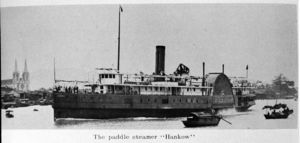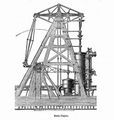Hankow
Slightly longer sister of the ship Pekin and Shanghai
Contents
History
Hankow was the last of the Yangtze steamers commissioned from A. & J. Inglis and the last side-wheeler paddle vessel built for C.N.Co. - all future craft being screw propelled. She was employed initially on the Middle Yangtze River, but proved suitable for use on the Canton River, and in 1886, was placed on C.N.Co.’s daily overnight Hong Kong-Canton passenger service. This service operated jointly with the Hongkong, Canton and Macao Steamboat Company.
As a result of this re-deployment, Hankow had a starring role in the formal cession of the New Territories to Hong Kong, when she was commissioned to convey H. M. Governor’s party to Tai Po, where there was a flag-raising ceremony to mark the occasion on 7th April, 1899.
1874. Delivered to CNCo. as Hankow. Similar to her earlier sister ship Pekin. The machinery similar to the Pekin with the increased engine power of 400hp.
On the 14th October, 1906, Hankow was gutted by fire, whilst alongside the Canton Steamer Wharf at Hong Kong, as a result of a passenger's cooking stove overturning. One hundred and thirty people were killed in C.N.Co.’s worst-ever (non- wartime )disaster.
In 1907, Hankow was towed to Shanghai and converted to a hulk. After this, she was towed to her namesake port on the Yangtze, where she began a new life as a pontoon wharf, with her holds used as a floating godown for transhipped cargo. In 1930, the hulk was transferred to Shasi, and in 1938, to Ichang, where she was destroyed in American bombing raids, during the Second World War




